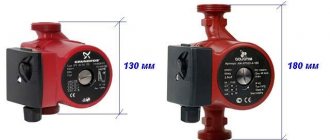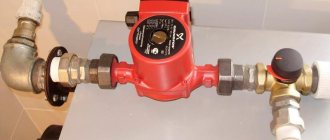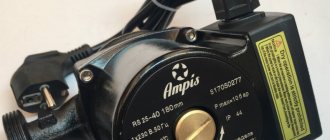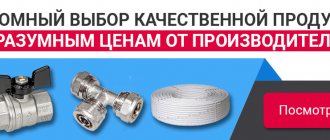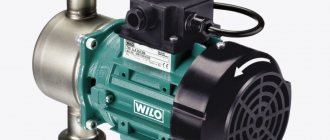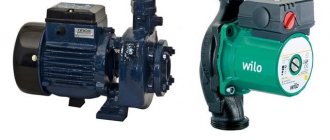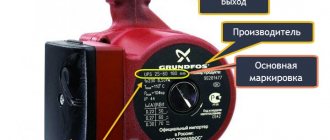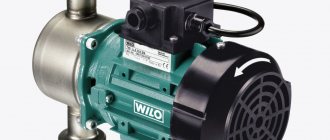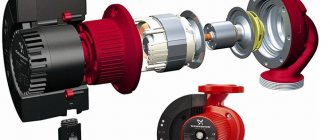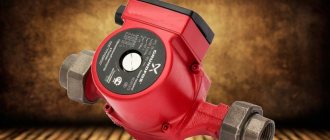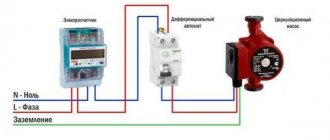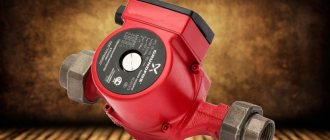A circulation pump is a device that ensures forced movement of coolant inside the heating system.
To choose the right pump, you need to understand at least a little what it consists of and how it works. Its main principle is forced circulation of water or other coolant in a closed system. This way the heating devices and the air in the room heat up faster.
The pump is designed to act on liquid, which, under its action, enters the heating system pipeline. At the same time, the impeller rotates, and the pipe creates a vacuum and continuous circulation of the coolant.
Advantages and disadvantages
Among the advantages the following can be noted:
- Heat is distributed evenly throughout the building , so all rooms have the same temperature. This avoids cases where large rooms are colder than small ones.
- The system can be adjusted.
- Automatic mode , thanks to which the pump operates continuously, or operates in the set mode.
- Functionality. The operating temperature range of the device is from +2ᵒС to +130ᵒС, so the pumps work with both water and ethylene glycol.
- Good pressure. When the system is given normal pressure, all adjacent equipment will work properly.
- Variety. Therefore, the pumps can be used for both small and large rooms.
The disadvantages include:
- The pump itself is inexpensive, but it consumes 40–80 watts of electricity around the clock, which is a considerable expense.
- The operation of the entire system directly depends on the supply of electricity. This problem can be avoided by installing, for example, a diesel generator in advance.
- There are additional costs for the purchase of taps, filters, etc., which actually increases the cost of the pump.
- Installing the device also costs money, but you can save on this if you do it yourself.
Why does a gas boiler need power supply?
With the advent of closed combustion chambers, gas units became dependent on electrical networks. Electricity consumption in such boilers is determined by the composition and amount of electronics in its internals.
And it is already allowed to install them not only in an isolated boiler room, but also in kitchens and bathrooms. From a security point of view, they have a high level of protection.
Let's list what exactly requires energy consumption:
- electric ignition;
- circulation pump;
- fan in a closed combustion chamber;
- automation (adjustment of gas supply, as well as sensors for draft, gas pressure, water, etc.).
A gas boiler with electric ignition ignites automatically from an electric spark. There is no ignition wick, which constantly burns in other ignition systems; gas is not wasted on its combustion.
At the moment an electric spark appears, some electricity is wasted, but the moment itself lasts a fraction of a second. At the same time, the electricity consumption is minimal; gas savings due to the missing igniter cover these costs. The only negative is that if there is no electricity, the boiler equipment cannot be started.
If the power supply to the network suddenly disappears, the gas cut-off device will operate. When power appears, the electric ignition will restart the heating system again without human intervention.
The circulation pump is what dramatically increases power consumption! But it is possible to minimize costs when operating a gas boiler if you use thermostats in all rooms, integrating them into the overall circuit for powering the pump and operating the boiler.
The programmer also significantly increases the economic result. The thermostat only helps to maintain a stable set temperature, and the programmer is able to set day/night operating modes, changes by day of the week, etc.
A fan (turbine) in a closed combustion chamber also consumes electricity, but less than a circular pump. The costs are justified by improved smoke removal. A boiler with a coaxial chimney does not burn oxygen in the room, does not allow carbon monoxide to escape, and is less noisy.
Automation in a gas boiler increases its final cost, but with it, controlling the heating system comes down to setting the desired temperature and pressing just one button.
Electricity is needed to operate the controller that regulates the gas supply and many sensors. Its consumption depends on how complex the automation is, but in general we are talking about low-cost energy consumption.
Constructions
There are only two types:
"Wet"
The device is placed in a liquid, which is a cooling lubricant for a running engine.
Among the advantages of “wet” type pumps are:
- Quiet operation.
- Light weight and size.
- Economical energy consumption.
- Long-term work without interruptions.
- Ease of repair.
They have only one drawback - low efficiency. It does not exceed 50%, so such devices are better suited for small domestic buildings.
"Dry"
Its design is different in that the rotor does not come into contact with the liquid.
Compared to the previous type, its efficiency is 80%, but there are the following disadvantages:
- Noise during operation , so it is better to install them in a special enclosed area;
- High requirements for cleanliness of liquid and air to avoid depressurization of sealing rings.
“Dry” are produced in three variations: horizontal, vertical and block. This setting is based on the location of the motor inside the device.
Types and selection criteria
There are three types of circulation pumps, which differ in the source of pump energy: soil, air or liquid:
- A ground heating system is more suitable for owners of private houses who can use a small area of soil. This species is stable, because the temperature of the earth practically does not change even over several years.
- The air system is widespread among Russian residents. It is accessible and easy to use.
- And the most common type is a system that uses water as an energy source. Moreover, the liquid can be used both from the water supply and from reservoirs, rivers and lakes.
Criterias of choice:
- Performance. This is the main parameter that you need to pay attention to when purchasing. And if the rule “the more is better” most often applies, in this case it does not work. Performance should be selected directly according to need. If the pump is more powerful, it will waste more electricity and run louder. There are special formulas for calculating productivity that allow you to determine the required value for each case. These formulas will be listed below.
- Pressure In other words, it is the pressure used to lift the liquid. This parameter also needs to be calculated in advance, using values from the design documentation for the structure of the heating system.
- Room volume. Of course, different buildings require different devices, so the size of the premises is also a significant parameter when choosing.
- Manufacturer's reputation. Nowadays there is a wide range of products available, from unknown Chinese companies to well-advertised European leaders. Most likely, the former will be much cheaper, but their quality is also worse, which significantly reduces their service life. If the rotor breaks down, replacing it can cost almost the cost of the product itself. That is why it is recommended to choose a device from reliable and trusted manufacturers.
Calculation formulas
Without carrying out the calculations below, it is not possible to select the right pump, so this point is simply indispensable.
Productivity
This parameter in calculations is usually denoted by the letter Q and shows how much heat can be moved by the pump per unit time.
The formula looks like this:
Where:
- Q —volume flow, m 3 /h;
- R — required power for the room, kW;
- TF is the value of the liquid temperature at the system inlet, ᵒС;
- TR is the temperature of the liquid at the outlet of the system, ᵒС.
Best manufacturers and cost
Nowadays, quite a lot of manufacturers are engaged in the manufacture of circulation pumps. Among them: Italian companies General Hydraulic, Dab, Speroni, as well as German ones - Unitherm, Wilo and Grundfos. The last two brands provide a wide range of their products, so among them you can easily select the necessary product of any parameters.
The cost of such products directly depends on technical characteristics, such as power and pressure, as well as on the factory equipment and additional services (control panel, speed switching, material and types of seals).
Also, the reputation of the manufacturer is considered an important fact. As mentioned earlier, the best companies produce guaranteed reliable products, but they also cost more.
As an option, let’s consider the cost of two popular models with approximately the same parameters: one is cheap, and the second is a popular model among the best companies.
This will make it possible to determine the price range:
- Vortex HZ 401 – DN25 – 3430 rub.
- Grundfos ALPHA2 25-40 – 9560 rub.
Tips for choosing
- Previously it was said that pumps can be with “dry” and “wet” rotor types , as well as using manual or automatic speed control systems. Experts recommend using circulation devices whose rotor is immersed in liquid. This design is not only quieter, but also handles the load better.
- When choosing a circulation pump, you should pay attention to the housing material. Stainless steel, brass or bronze are best, but cast iron products are best avoided - they will not last long under such conditions.
- The efficiency of the device will depend not only on the factory parameters, but also on correctly performed calculations, so do them twice.
The heating system of a country house is a closed circuit in which water circulates, heated at one point. The circuit includes a circulation pump that maintains fluid movement. Every pipe bend, narrowing, and devices installed on the line create hydraulic resistance. The temperature difference is not enough for the coolant to move along a branched circuit in a two-story house. The use of a pump makes it possible to install a heating boiler not only in the basement.
Design and principle of operation of the circulation pump
The circulation pump is an electric motor housed in a steel housing. Its rotor transmits rotation through the shaft to the impeller. The rotation of the impeller creates a vacuum at the inlet pipe, drawing in the coolant. When turning, the impeller releases liquid under pressure into the circuit due to centrifugal force. A pressure is created, which is the driving force of circulation in the heating circuit.
A circulation pump for heating systems is useful, the water forcibly accelerates its movement, cools down slightly, the load on the boiler is reduced, and the radiators in all rooms heat up equally. Saves up to 30% of fuel for heating the room with a correctly configured circuit.
The design of the heating system and the selection of components must be entrusted to a specialist.
There are many circulation pumps, but “wet” and “dry” type designs are used in thermal circuits. If the rotor is separated from contact with the liquid by a partition of o-rings, the design is considered dry. During operation, a film of water forms between the rings, which, due to surface tension, seals the electrical part. As the rings wear, they are tightened by a control spring. Depending on the design layout there are:
Pumps are used in systems with high flow rates, used in boiler houses that heat several buildings. They have good efficiency - 80%, but require professional maintenance.
In “wet” type devices, only the stator is isolated from the aqueous environment. The pump operates with low noise, does not require maintenance, is used in small circuits, despite the efficiency of about 50%. The power consumption of the pump is low; energy consumption per hour when turned on periodically is 50-200 watts. The pumps have three-stage load adjustment.
Consumption
The energy intensity of a pumping station is determined based on its power. Manufacturers offer pumps of different power: from six hundred watts to one and a half kilowatts. These are devices for domestic use, more powerful systems are intended for industrial use. Pump performance depends on the volume of pumped water and pressure.
Different types of pumping equipment have their own characteristics and technical characteristics. Let's look at the types of devices in more detail.
The issue of energy saving is becoming increasingly relevant. It is possible to save and reduce costs not only with the help of energy-saving lamps, but also through the use of energy-saving appliances and devices. A circulation pump belongs to this category. It is used for forced circulation of media in a closed system. Thanks to the continuous movement, the temperature of the media remains high and a large amount of energy is not wasted on reheating. This leads to resource savings.
At the end of the nineties of the last century, a scale was developed to determine the class of energy consumption. Each device received a letter designation from A to G. Equipment marked A is considered the most economical, the letter G indicates high energy consumption. But the established markings are constantly being improved: you can find the designation A+, A++ and even A+++. As for pumping stations, they are currently only marked with the letter A.
The advantage of the circulation pump is its low energy consumption.
This is due to the constant improvement and improvement of the quality of the device. In particular, in hydraulics and electric motors. The advantages of a circular pump include:
- very fast system warm-up;
- high system efficiency;
- reliability;
- ease of operation.
There are several types of circulation pump. They are divided according to the operating principle into wet and dry. Each of them has its own characteristics and advantages. The devices are capable of pumping liquid from two to one hundred and ten degrees Celsius. Electronics allows you to automatically regulate the pressure in the system. Automation helps improve the accuracy of the pump and respond to changes in the heating system.
The best companies offering circular stations are Vilo and Grundfos.
The purpose of the grundfos pump is to use it in various heating systems and for underfloor heating. Heating and the use of circulation pumps for heating have proven themselves to be excellent.
To calculate the power consumed by the company’s pumps, you need to know the size of the device: it ranges from five to twenty watts to thirty-two to sixty watts. It is possible to reduce the amount of electricity consumed through the use of magnetic rotors, a frequency converter, and a compact stator.
The energy consumption of circular pumping equipment can be calculated using mathematical calculations. Experts compared the energy consumption of a conventional circulation pump and Alpha2 equipment from Grundfos and concluded that the latter is more than three times more economical.
The circulation pump of the German company Vilo also deserves attention. The advantages of the wilo pump are its low power consumption. The model consumes from three to twenty watts per hour. Energy consumption class - A. Data on current energy consumption and accumulated kilowatts are displayed on a convenient display. Pumping equipment is intended for heating and air conditioning.
The amount of electricity consumed depends on the type of pumping station and varies from half to one and a half kilowatts per hour. The total amount of resource consumed depends on the intensity of use of the pumping unit. In order for the device to cope with its task, it is necessary to select the equipment correctly, taking into account the specific task for which the equipment is selected.
Centrifugal circulation pumps use centrifugal force to move liquid, which occurs under the influence of the working piston on the liquid. The main purpose of a centrifugal pump is to provide irrigation to household plots. But in addition, aggressive and abrasive liquids are pumped. The devices are characterized by a long service life and high efficiency. To determine the power of a well pump, you need to calculate how many watts are spent per hour of operation and multiply by the operating time per month.
A heat pump is an excellent solution for heating a home. Climate control is the most comfortable characteristics of this type of equipment. It is indispensable if the house does not have centralized gas heating.
Heat pump power is a fundamental technical characteristic.
It is selected taking into account heat loss, but such calculations must be made by a specialist. There are special formulas that help you choose the right equipment.
Criteria for choosing a circulation pump for heating
It is important to choose the right circulation pump for heating according to the parameters. The meaning is:
- heating area;
- temperature conditions of the premises;
- temperature difference between supply and return;
- functional features of the heater;
- pressure in the circulation system,
- network feature;
- coolant used.
The result of the correct selection of equipment will be a comfortable temperature in the building.
The choice of pump power depends on the area of the room, temperature requirements and how many degrees the coolant in the boiler is heated. There are thermotechnical calculation formulas. We proceed from average indicators when calculating the characteristics of the circulation pump:
- The pump performance is set based on the temperature difference - 30-35 0. The power of the heating boiler is divided by the difference, the flow rate is obtained, and this is the productivity.
- For 10 m of pipe length, 0.6 m of pressure is required. The regulated value for the pump is indicated in the passport and is measured in meters of water column.
- The pump ensures circulation in all radiators, based on 5 sections per 10 m 2. The coolant flow in the system is calculated based on the boiler performance. A 25 kW boiler heats 25 l/min, a 15 kW radiator needs a flow rate of 15 l/min.
- The diameter of the heating pipes must correspond to the cross-section of the pump connection pipes. It is accepted that one pump will pump 80 m of the circuit.
The longer the circulation circuit and the larger the cross-section of the pipes, the more powerful the circulation pump required for heating the house. If the coolant is not water, it is more viscous, the pump requires increased power.
If there is one booster pump in the system, it must be selected with a power reserve. Periodic adjustments to the pressure in the system can be performed by a less powerful device.
The choice of heating pump brand depends on the buyer’s capabilities. Well-known brands are expensive, work silently and do not require revision for years. These brands include pumps from European manufacturers. Chinese devices are several times cheaper, but their service life is short, there is backlash, noise and the engine burns out. Russian models are classified as middle class, their cost is 2 times cheaper than famous manufacturers.
Calculation options
The “R” parameter is determined not only by the relationship indicated above. There are other ways to define it.
In Europe
In European countries they do it simply. To do this, take standard values identified experimentally:
- for small private houses, thermal energy consumption is (R) - 100 W/m²;
- for apartment buildings - 70 W/m²;
- for industrial buildings - 30-50.
For northern regions
The above European standards are suitable only for Russian regions with a mild climate. Therefore, for the northern regions, other parameters are used, which are recorded in SNiP “Heating networks” under number 2.04.07-86.
- For houses with no more than two storeys , the specific thermal power of the heating boiler is 173-177 W/m².
- For houses with a height of more than two floors, this figure varies from 97 to 101 W/m².
Circulation pump installation location
When installing the pump, it is important to provide free access for its maintenance. It is optimal to install the equipment on the return line in front of the boiler. This contributes to:
- uniform supply of feed water to the system;
- on less hot water the pump will work longer;
- no air pockets will be created in the boiler.
The pump impeller is installed horizontally and operates under the fill.
The pump is mounted only on a bypass, which must have a cross-section smaller than the main line with the obligatory inclusion of a check valve. This will ensure the coolant circulates along the main line in the absence of electricity. The bypass must be cut off to allow repair of the pump.
Grundfos circulation pump design
According to experts, the Grundfos circulation pump is the best. In global consumption, 50% of all heating systems are equipped with pumps of this brand. A subsidiary of the Danish concern Grundfos was opened near the city of Istra in Russia.
Devices with dry and wet rotors are available. Dry systems are equipped with an additional fan to cool the engine, operate noisily, and are installed in boiler rooms. For a home network, a wet rotor system from the UPS series is offered. These devices are only available in Germany and Serbia. There are many signs by which you can detect a fake. A real pump from the manufacturer cannot cost less than $130-150.
The device operates for up to 10 years without repair, provided that the operating conditions are followed. If you install the device yourself, you need to keep it indoors for at least a day. Mount the circulation pump only on a horizontal section of the pipeline. Three-phase connection, from a separate line.
The home improvement product line offers Magna multi-functional pumps of varying capacities and Alpha self-adjusting pumps. The device itself adapts to the set mode, reduces parameters at night, and when there are no residents in the house, it saves energy.
Common breakdowns
The most common problem that causes equipment that provides forced pumping of coolant to fail is its prolonged downtime.
Most often, the heating system is actively used in winter, and is turned off during the warm season. But since the water in it is not clean, sediment forms in the pipes over time. Due to the accumulation of hardness salts between the impeller and the pump, the unit stops working and may fail.
The above problem can be solved quite easily. To do this, you need to try to start the equipment yourself by unscrewing the nut and manually turning the pump shaft. Often this action is more than enough.
If the device still does not start, then the only solution is to dismantle the rotor and then thoroughly clean the pump of accumulated salt deposits.
Description of the Wilo pump
Wilo circulation pumps made in Germany are used for pumping liquids in water mains, heating systems, and in technical processes.
Models of pumps for heating systems are assembled in series and satisfy any need; they are manufactured in dry and wet versions. We list the series offered by the manufacturer:
- Star, modifications RS, RSD, Z;
- TOP – Z, D, S;
- Yonos – Pico, Maxo;
- Stratos – Pico, Eco-St.
The equipment is not inferior in quality to Danish equipment, but can operate in a temperature range from 120 to -10 0 C. One installation can circulate a heating circuit of 750 m 2. The pumps create a pressure of 2.2 - 12 meters. Depending on the power, the device weighs 2.2 - 8 kg. The device operates silently.
Wilo pumps are suitable for heating systems with radiators and for hot water supply. The service life of the equipment without repair is stated to be 8 years for the wet version.
High-quality heating pumps - video
Price factor
When choosing a circulation pump, the cost of the device itself and its efficiency in operation are important. As a rule, the operation of the pump is justified by savings on fuel consumption, and the cost of the model itself is determined by its performance. In Moscow, the price range for pumps is very large. Conventionally, they can be divided into 3 categories:
For 3.5-7 thousand rubles you can buy basic functions, with a minimum operating life and most often one-time use;
Comparison of characteristics of pumps in the economy segment Source ms.decorexpro.com
- Devices costing 7.5-20 thousand are “workhorses” that accurately provide the declared characteristics, with a service life no less than that specified by the manufacturer and with several degrees of protection and an optimal safety margin;
- VIP systems with full automation, a set of additional functions, a high safety margin and the ability to provide a large volume of heat will cost from 20 to 45 thousand rubles.
Features of a modern heating system for a country house
Depending on the region, the heating season in our country lasts on average 6-7 months. Because Energy prices are rising all the time, and among owners of country cottages there is increasing interest in building energy-efficient houses, i.e. buildings where all energy losses are minimized. Practice shows that with a competent approach to the process of constructing such a house (based on thermal engineering calculations), the funds spent on its construction are returned in the form of reduced energy costs.
But often one important point is overlooked - the construction of an energy-efficient, and therefore economical, house requires solving a whole range of problems. In addition to insulation and installation of a ventilation system with a recuperator, to minimize costs it is necessary to increase the efficiency of the heating system.
The heating “engineer” of a country cottage includes a wide variety of equipment. These are solid fuel, gas, electric or diesel boilers, underfloor heating systems or wall radiators with thermostatic heads, etc. Therefore, the heating system of a country house is equipped with circulation pumps.
Often, conventional (unregulated) circulation pumps are installed in the heating system, operating at a constant speed all the time or having stepwise adjustment of the coolant pressure in 2-3 ranges.
Advantages of a circulation pump with an intelligent control system
Unregulated pumps in heating systems consume a large amount of electricity because... During the entire heating period they constantly operate at maximum mode. While in fact most of the time the heating system operates in partial load mode.
For example, in case of sudden warming (this often happens in the middle of winter), the user lowers the temperature of the coolant and its pressure, because Heating devices do not require increased heat transfer. Also, the heating system is not required to operate at maximum efficiency at the beginning and end of the heating season, when cool weather has just set in outside and severe frosts have not yet arrived. When changing day and night, when leaving home for work during the day, when using thermostatic heads installed on radiators, you can lower the temperature in the rooms and, thereby, save money on heating.
That is, during the entire heating season, maximum performance is required from the circulation pump for only a limited period of time. Consequently, the pump must flexibly adapt to constantly changing operating conditions and the personal preferences of the people living in the house.
Older generation pumps allow you to manually select one of several constant speeds (usually two or three). Often these pumps can operate at maximum speed even if all radiators are closed. This leads to unreasonably high energy consumption.
Modern “smart” circulation pumps are equipped with highly efficient motors with automatic power control. This optimizes the hydraulic parameters of the pump in all modes of operation of the heating system and, especially, in part-load modes, which can significantly reduce energy costs.
Additional energy savings are achieved by activating the automatic speed reduction mode and the Dynamic adapt function. This is a function of continuous dynamic adjustment of the operating point in the partial load zone of the pump.
Due to the constant adaptation of the pump operating point, as well as the automatic air removal function, the use of electronic pumps avoids the occurrence of noise in the system, which is especially important for residential premises
What power reserve should the selected UPS have? Starting currents of pumps.
The power reserve of a UPS for a boiler room directly affects the reliability of the uninterruptible power supply system for heating a home.
The main weak point is the output unit of the uninterruptible power supply, because The entire boiler is powered through it. Circulation pumps as part of any modern heating system are the main powerful consumers of electricity and their power affects the power of the UPS used. In normal mode, the pumps consume their rated power stated in the passport. However, it is necessary to take into account their starting power. This is the power from the moment power is applied until they return to their normal mode. Usually this is no more than 2-5 seconds. During this short period of time, the current consumption from the UPS is significantly higher than the standard one. And the higher the current consumption, the correspondingly higher the power consumption of the pump. Power is the product of current and voltage. For example, a 60 W pump in normal mode consumes a current of 0.273 Ampere, and when overclocked (turned on), the inrush current can reach 0.8 Ampere, i.e. three times. Accordingly, the power at this moment is 220 * 0.8 = 176 W. Many modern pumps incorporate a soft start system to ease the initial load on the components; it is preferable to install such pumps on the side of the UPS selected in the future. Each UPS has an overload capacity parameter of 20-30% of the nominal, this is the ability not to turn off during short-term load peaks, but three times the permissible power covers this ability. In heating systems where there is not one pump, but 3-4 units and at the moment of switching on they start simultaneously, then through simple mathematical calculations an overload of 464 W is obtained! Thus, an uninterruptible power supply supplying such a load must withstand 176 * 4 = 700 W. In any UPS passport there are two characteristics: rated (long-term) power and maximum (peak). Please be sure to carefully read and compare the power of your system and the UPS before choosing and purchasing.
The amount of reserve power of the UPS should also be influenced by the factor of increasing the number of pumps in the boiler room. If you want to increase the area heated by the boiler, you will have to install an additional pump, and an additional pump is another consumer of electricity, i.e. system power increases.
In the case of using line-interactive UPS, it is necessary to take into account the characteristics of the voltage corrector built into them. The peculiarity of these correctors (AVRs), or as they are beautifully, but not entirely correctly called, voltage stabilizers, is the reduction in rated power when the input voltage is less than 180-190 volts. This fact is often not indicated in passports and operating instructions. But the laws of electrical engineering cannot be circumvented by the laws of marketing! And the result is the boiler stops when the input power is too low due to the wrong choice of UPS in terms of power. The fact is that the transformer inside the UPS, with an input voltage reduced, adjusting (increasing) the voltage level at its output to 220 volts, is no longer capable of operating at 100% of its rated power and, with 150 volts at the input, is capable of “giving to the load” only 50 -60% of its rated power. If your network is characterized by frequent and prolonged voltage drops, then the power reserve should be plus 50%. In other words, if the load is 250 W, then a UPS with 500 W nominal, not maximum, is needed. Then we can talk about the reliability of the system.
Example: UPS Energy PN-500. Rated power 230 W. Maximum 350 W. Can be used for pumps up to 120 W. Provided the input voltage is in the range of 180-250 Volts.
Operating principle of circulation pumps with electronic control system
As mentioned above, in our climate zone there are significant fluctuations in ambient temperature. Regardless of weather conditions, the user needs to ensure a constant comfortable air temperature in living spaces.
At low temperatures, as a rule, all radiators are open, requiring maximum coolant supply. As the outside temperature rises, some of the radiators are closed - less coolant passes through the system.
Modern “smart” circulation pumps are able to adapt to changing system loads. The electronic pump control system allows you to automatically change the motor speed, depending on the state of the system (the number of open radiators). Unlike standard pumps, with the ability to manually select one of two or three rotation speeds, the built-in frequency converter of “smart” pumps automatically changes the motor rotation speed with high accuracy, which allows you to instantly respond to changes in conditions in the heating system. Thus, the use of circulation pumps with an intelligent control system significantly reduces energy consumption.
Also, such pumps have the ability to select one of several control modes, which allows for optimal pump operation in a particular system.
Depending on the established control method, the pump electronics maintain or linearly change the set value of the differential pressure, in accordance with the current state of the system (for example, the number of open radiators), at the same time the pump flow changes. The motor rotation speed is constantly changing, which means that the pump automatically, without user intervention, adapts to changing operating conditions.
Electricity consumption
You can often hear that a pump consumes a lot, but how much does it really mean?
Circular pumps do not lift water from the depths, but simply ensure its movement in a closed system. For this reason, the devices provide high performance with low power, usually sixty to one hundred watts. This is approximately the same as a regular incandescent lamp.
The power consumption of the pump and its size depend on many parameters. You can find energy-saving models with electronic filling. They are equipped with electronic frequency control and belong to the A-class. The devices are capable of automatically adjusting power in case of network parameters deviation. Despite their higher cost, the device pays for itself very quickly.
Before we find out how many kW we are consuming and calculate the electricity consumption of the pump, it is necessary to obtain information about the thermal power of the device. The following indicators are accepted:
- small private house - one hundred kilowatts (0.1 kilowatts) per square meter;
- apartment in a multi-storey building - seventy watts per square meter;
- industrial premises - from thirty to fifty watts per square meter.
It is necessary to independently calculate the required thermal power, taking into account the purpose and degree of thermal insulation. There are many convenient and understandable tables available on the Internet.
It is difficult to calculate how much electricity a pump consumes. Many aspects are taken into account. In an hour, a conventional pump consumes about four watts; in a day, the device consumes from forty to eighty watts. Indicators may increase or decrease depending on the weather, the degree of insulation of the room, and the intensity of use.
You can choose the right pump taking into account the following parameters: performance, pressure, design, operating efficiency. If you are at a loss as to which device to choose, seek help from a specialist.
Energy saving has come a long way from the call “When leaving, turn off the lights.” We already know that you can save money not only with the help of a light bulb, but also due to the energy-saving capabilities of equipment, including the circulation pump.
Show your class!
Back in 1998, a special scale was developed. Since then, before releasing the device for sale, manufacturers have been testing in standard operating mode. Each device is assigned a certain energy consumption class - from A to G. To date, the scale has exceeded its original limits and continues to change constantly. If until recently, “excellent” savings were classified as A++, now more and more models are receiving the A+++ label. However, with regard to pumps, only limit A has so far been reached; this is the most profitable option in terms of energy consumption.
If you live permanently in a cottage outside the city, the beginning of the heating season entails an increase in electricity consumption. So now is the time to talk about energy-saving glandless circulation pumps. The body of these units is made of cast iron, the working shaft is made of stainless steel or ceramics. They are designed to pump liquids with temperatures from +2 °C to +110 °C. Their low energy consumption is due to improvements made in the hydraulics and electric motor.
The electronic control system allows you to automatically regulate the pressure in the heating system. Built-in frequency converters automatically change the engine speed depending on the needs of the heating system. Automation of various processes and a large number of sensitive sensors make it possible to maximize the accuracy of pump settings, and the entire device to instantly respond to changes in conditions in the heating system. Additional modes – “night”, AUTOADAPT – make it possible to reduce the rotation speed to the limit at a certain time. As a result, we see a sharp drop in energy consumption compared to standard circulation pump models.
Grundfos
One of the latest developments from Grundfos is Alpha2. The pump is intended for use in single-pipe and two-pipe heating systems, as well as for “warm floors”. Different sizes have different power consumption: 5–22 W – for pumps Alpha2 25–40 and Alpha2 32–40 (with a head of up to 4 m); 5–45 W – for pumps Alpha2 25–60 and Alpha2 32–60 (pressure up to 6 m). A reduction in energy consumption is achieved through the use of a permanent magnet rotor, the use of a frequency converter, a compact stator with segmented windings, a seamless sleeve made of special stainless steel, and an improved hydraulic part. Additional savings are provided by the AUTOADAPT function, which analyzes the operation of the pump and adjusts its characteristics to the needs of the system at the moment.
A class D circulation pump consumes about 500 kW/h per year, an Alpha2 circulation pump consumes about 90 kW/h (80% less). Savings amount to 410 kW/h per year. The price of electricity in the Moscow region is 3.38 rubles per kW/h; compared to a conventional Alpha2 pump, it saves 1,385 rubles per year. Thus, in 2–2.5 years it will completely pay for itself.
Wilo
Savings from a German manufacturer - single circulation pump Stratos PICO. A relatively new model, launched on the Russian market last year. Stratos PICO is designed for both heating and air conditioning systems. The power consumption of the model is from 3 to 20 W/h. Accordingly, the consumption per day is from 72 W. It is also assigned energy consumption class A. As in the previous model, all information about current energy consumption and accumulated kWh are reflected on the digital display.
Economic benefits of using a “smart” circulation pump in the heating system
What are the savings when installing a “smart” energy-saving pump in the heating system? This is a key question that interests any developer who is planning to buy a circulation pump with an electronic control system.
The benefits must be considered holistically and, most importantly, in the long term. For example, a typical unregulated circulation pump for a heating system consumes on average 500-800 kWh per year. For comparison: TV - up to 200 kWh per year, washing machine - about 200 kWh per year, electric stove - 450 kWh per year, because a conventional circulation pump operates constantly and at maximum mode. But the above household equipment is turned on only periodically.
The minimum power consumption of a modern energy-efficient circulation pump is 3 W, and the average annual consumption will not exceed 50 kWh.
Therefore, smart pumps can save up to 90% of energy compared to standard pumps, as they automatically adapt to changing system parameters and are equipped with highly efficient, economical electric motors.
We also remember such an important factor as home autonomy. Suburban residents are well aware that sometimes there are power outages, substation failures and power line breaks. To ensure that the heating system continues to operate, it is equipped with an uninterruptible power supply. The UPS, powering the circulation pumps and the boiler, will allow the heating system to function until the centralized power supply is restored.
By installing an energy-efficient circulation pump with low power consumption, the user significantly increases the operating time of the heating system from the UPS. Or it can reduce the cost of its installation, because You will need an inverter and a battery pack of lower power.
And our video shows the nuances of installing a combined heating system in a wooden house.
Counting electricity
A large number of questions came: “How to calculate: how much electricity is needed for a country house/cottage?”, “How to save electricity in a country house, cottage”, in connection with which I decided to devote a separate article to this.
How much electricity do you need for a country house/cottage?
All energy consumption consists of devices that consume this same energy; devices are divided into “permanent” and “temporary”. Constant ones are those that must work unconditionally (constantly) and it is necessary to reserve power for them. Temporary ones are switched on as needed and do not require power reservation.
Constant, we reserve power:
1. Water pump (if the water supply is not central) - 1.5 kW
2. Heating boiler (gas, liquid fuel) as a rule, these boilers, despite the fact that they do not operate on electricity, still require a small amount of electricity (ignition, turbine) + a circulation pump that drives water through the pipes of the heating system - total consumption in area - 0.5 kW.
3. Normal lighting with energy-saving or LED lamps - 0.5 kW (with incandescent lamps - significantly more)
4. Refrigerator, TV, computer, etc. - 0.5 kW
5. Water heater (if the water is heated by electricity) - from 1 kW
TOTAL: 4 kW, or better 5 kW
The given figures are very average; you will still have to calculate it after the fact, since lighting alone with ordinary lamps (not energy-saving) can consume 0.1 kW for each light bulb, and there may be several dozen of them.
Temporary, can be turned on one by one, we reserve electricity for them based on the most powerful 2.5 kW
1. Washing machine - 2.5 kW
2. Dishwasher - 1.5 kW
3. Electric kettle (reasonable) - from 1 to 2.5 kW
4. Air conditioning (normal - read the corresponding article) - from 1 kW to 1.5 kW.
We get 5 kW necessarily and 2.5 kW are temporary consumers TOTAL 7.5 kW, despite the fact that temporary consumers will not turn on all at once.
It is worth mentioning separately about electric stoves and electric heating of the cottage:
1. A normal electric stove consumes 9 kW when all burners are turned on, which in most cases is simply unacceptable. Why this is necessary, I don’t know, it’s easier to buy a gas stove and connect it to a gas cylinder, it’s cheaper, faster and doesn’t require power. When purchasing a stove, make sure that the stove comes with replacement propane nozzles and you can change them. There are enough gas refills; a cylinder with normal consumption lasts for four to five months. Read a separate article about slabs HERE
2. I have already written about electric heating; this invention, a miracle of masters, puts you in a trance. For heating 10 sq.m. a cottage (normally insulated) requires 1 kW of electricity, so to heat a cottage with an area of 200 sq.m. 20 kW required + required reserve of 7.5 kW for a total of 27.5 kW, I don’t know where you will get such power from. In most cases, heating with electricity leads to exorbitant costs and the impossibility of living in a cottage in the winter.
How to save electricity in a country house/cottage?
For reference: there are 1000 watts (watt) in 1 kilowatt (kW).
1. Learning to read and count
Every electrical device you buy contains information about energy consumption, I highly recommend that you study it carefully. Why do you need a 3 kilowatt kettle? Boil 1 cup of tea? Can't a 1 kW kettle do this? Why buy a 5 kW industrial washing machine; a regular 2.5 kW washing machine will wash things worse?
So, if your electrical power is limited, and in cottages this is very common, then you need to learn to read and count, otherwise by connecting one washing machine you can select the entire electrical line and your machine will constantly turn off.
Before you buy a powerful device, think about how necessary it is and whether you can replace it with a less powerful one.
On a standard incandescent lamp its energy consumption is written, as a rule it is 60/80/100 watts, while you can achieve similar illumination using energy-saving lamps, the light from which is the same, and the power consumption is almost 5 times lower, and for LED lamps 10 times lower.
For example, a 5-arm chandelier with 80-watt incandescent lamps consumes 80x5 = 400 watts (0.4 kW), energy-saving lamps will consume 80 watts (0.08 kW) for the entire chandelier. How many chandeliers do you have in your house?
Recently, LED lamps have appeared on sale, the consumption of which is even lower (10 times) and their durability is many times higher than any other, I recommend.
Street lighting - install a light sensor and enjoy, the lighting works only when it is needed.
Spotlights: I understand that a regular spotlight costs 200 rubles, but it only consumes 0.5 kW, isn’t it easier to buy an LED one (0.035 kW) or one with energy-saving lamps (0.15 kW)? They are more expensive, but quickly pay for themselves.
3. Air conditioners - separate article HERE
4. I have already written about electric heating HERE several times.
5. Electric stoves, read the relevant article HERE
Recently, two tariff electricity meters have begun to be installed. The bottom line is that at night electricity is THREE times cheaper than during the day. We read the instructions for dishwashers and washing machines and see that they have a delayed start timer. We turn on the start at night and sleep peacefully. The savings here aren't big, but why pay more?
If you have an electric water heater installed, then you need to think about the following:
- A lot of heating boilers can not only heat a house, but also heat water, and even if they can’t, no one is stopping you from installing a heat exchanger. We throw out the water heater.
- If you still need a water heater, then you should still calculate how much hot water you really need. Does it make sense to buy a 200-liter heater?
- Water heaters have several heating elements; we turn off the extra ones, since, as a rule, it does not matter how long the water takes to heat up.
- A instantaneous water heater is generally a utopia, for normal heating of running water you need at least 9 kW, do you have such power in reserve? And for what?
We distribute the loads across three phases:
As was described in a previous article on electricity: 220 volts differs from 380 in that 220 is supplied through one line, and 380 volts through three.
So life gave a crack (just kidding) and you were given an electricity connection of 380 volts 9 kW, 3 lines of 3 kW each.
If all devices are connected to one 3 kW line, then if the load is exceeded (for example, a 2.5 kW washing machine + 1.5 kW pump = 4 kW is turned on), the machine will turn off, so it is necessary to distribute these devices over different lines, so we connect the pump to one, and the washing machine to another, no problems.
Global distribution is done as follows: we determine permanent consumers of electricity (devices less than 0.5 kW can not be taken into account) we connect them to different lines, taking into account their operating principle.
Principle of operation: you need to take into account that the washing machine (2.5 kW) obviously consumes the water that the pump (1.5 kW) supplies to the house, therefore you should not connect both devices to the same line. For example, you can agree with yourself not to turn on the washing machine and dishwasher at the same time, so they can be connected to the same line.
1st line: pump, boiler (not electric), part of the light, part of the sockets.
Line 2: washing machine, dishwasher, part of the light, part of the sockets.
Line 3: water heater, air conditioner (normal), part of the light and part of the sockets.
As you can see, in such a scheme, all powerful consumers are distributed along different lines and we do not have the opportunity to overload the line, unless, of course, we turn on everything at once.
Fun of drunken electricians:
Your machine systematically breaks down due to overload and you call your neighbor, an electrician, to “take a look.” In this case, the electrician should look at the machine and the loads that go through it and tell you something like: “could you not turn on all the devices at once?” or “let’s redistribute the loads across three phases,” but in Russia this is not done and the electrician changes the machine, for example, from 16A to 32A and creates a lot of problems for you
1. Who told you that such a replacement is legal? If you have been allocated a certain amount of energy for your cottage, then it is limited to this same machine and replacing it means that you start stealing. The first check will reveal this point.
2. Who told you that the wires laid in your house will withstand this load and will not start to heat up, which can lead to a fire?
